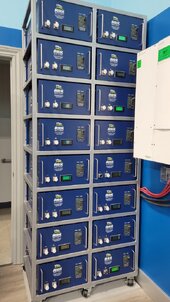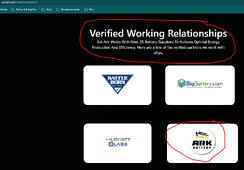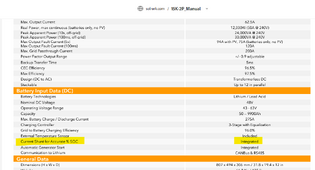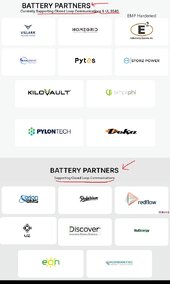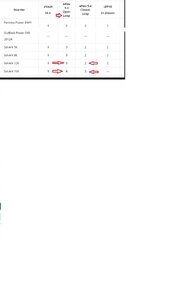Ark battery is not a Sol-Ark Battery Partner and it is not listed as working in closed loop coms with Sol-Ark Inverters. They state the have a "Working relationship" with them, whatever that means.
Maybe they are still doing development to get the closed loop system working.
Ark batteries have no smart BMS, and no comms ports period. As such, they won't ever have closed loop comms..... I believe I stated that before. Extremely robust batteries, they simply work! We can install them and walk away knowing they will work. The working relationship means that there have been meetings between the owner of Ark and Sol-Ark, that Ark batteries can be used with a Sol-Ark inverter, etc. Nothing to do with closed loop comms. And they do work perfectly fine with Sol-Ark inverters as long as you don't need % on the Sol-Ark itself.
Rubix GigaStack is the "new" Ark, same cells and quality, etc., but with smart BMS and closed loop comms.... Also more finicky due to the smart BMS..... exactly why Ark were originally designed with a "non" smart BMS. But now with how everyone pushes for closed loop, you either have to stay "with it" or you will lose out. Hence the smart BMS and closed loop comms.
My info on the Ark and Rubix scenario is, by the way, not word of mouth. It is from my firsthand connections to the company, and actually working side-by-side quite a bit....
Your drift of 15% is way higher than I would tolerate. The most I have ever let mine drift is 10%.
To be honest I highly doubt that the actual state of charge is drifted 15%. I suspect simply a drift of the "screen" on the battery, as the batteries had not been fully charged for a number of weeks. I could be wrong on that, but the nature of voltage difference between batteries causing charge to flow between units tends to keep from having too much drift. My own batteries at home (experimental units with smart BMS's, but running open loop) have a variation as well, and the one unit showed ~70-75% even after the whole bank got charged completely full, all the way up to around 56V last weekend. This is simply a drift of what the smart BMS believes the SOC is at. It would probably re-calibrate to 100% if I would take the charge voltage up to ~57 volts.
But even if there is 15% difference, what are we hurting? We see no adverse, strange behavior, no odd battery bank voltage drop etc.....
Let's say we charge then discharge 30% every day for 2 weeks, so that would be a 30% DOD every day (not actual numbers, just hypothetical) what is the difference (or the drawback) between the units that cycle between 15-45% vs the units that cycle between 30-60%? At the end of the day the each still did a 30% DOD...
Now if you would have one unit cycling at only a 15% DOD while the others did a 30% DOD, that is a whole other story. But we generally don't see a variation like that on LFP batteries that are of decent quality components, regardless of the brand. And also, closed loop comms will not adjust charging amps between units, to my knowledge, so it really won't help anything in terms of imbalance, other than shutting down discharge if one unit shows 0% (or whatever % you would set it) while the others would show, say 30%. But of course, as you can see from my personal bank with one BMS off by ~25%, I would have shutdown issues before the bank is actually low if I would be using closed loop! I really truly don't think it is possible to have a spread in actual internal SOC more than~10% or so, between LFP batteries with the same cells internally! If you look at voltage curves on charge and discharge, the way the voltage drops off in the bottom 25%, and they way it rises in the top 15-20%, I think it keeps them relatively well "balanced" out between units.... That middle 50% may be able to spread more, but you will hardly ever sit in the middle 50% for any extended period of time!
I am not a Solar Installer, I am Electronic Engineer & CE.
The only Solar installation I have done is my own.
I have worked on fixing issues with a few other installations but that is about it.
Speaking for myself, I am a Solar Installer and service technician with 10+ years of experience in the field. I have worked on hundreds, if not thousands of systems. Probably 95% of those were off grid, the other 5% grid tied or hybrid, with the last 2-3 years being more like 10-15% grid tied or hybrid. Probably 75% of the off grid and hybrid systems that I have worked on have some kind of SOC tracking device, all pretty much exactly what Sol-Ark has integrated specifically for batteries that do not have closed loop comms. Shunt based, often using a 500A/50mv shunt, tracking down to a fraction of an amp. Sol-Ark has this built-in so their inverter can be used with any 48V battery..... I believe they would say so themselves!
The Sol-Ark algorithm is simply inferior! I speak from experience....... I speak from all the other brands that I have seen work absolutely fantastic and both lead acid and/or LFP batteries, or even with salt-water batteries for that matter. These other units work with both open loop and closed loop LFP batteries..... In fact oftentimes in off grid installs we won't even bother using closed loop comms even when it is available, because open loop works so well, and maybe it's an existing Schneider system (or whatever brand) with existing shunt based SOC that works. So we adjust the settings for the new LFP batteries and walk away knowing it will work. But not so with Sol-Ark.....
I would think if you are an Electrical Engineer you would understand that sometimes the hardware is not the issue, but rather the software. And sometimes the end user/ installer sees the real world side of what works and what doesn't!
I find it very strange that you (I mean you personally) would continue to pose this as not an issue, when I have given examples of it not working, as well as the fact that I am also speaking from a number of years' experience on the subject (that you don't have)...?
As for issues with the 30K or 60K I have no idea why they would lie and since most problems come from the Firmware and as you said they are using the same firmware, I would expect that it works properly just like the 8/12/15K models.
You would expect that it works properly just like the 8/12/15K models....... perhaps you are not understanding that there are actually issues with those units...?
As far as why they would lie.... sometimes it is not so much the things that are said, as the things that are not said. Why would they want to tell you about an issue that has come up? It is simply common sense to expect that they won't be telling you if they had an issue come up! I would assume they would try to fix any issues to avoid having customers telling other people that their units have issues! But my concern is the fact that when I as an installer brought up issues, they did not listen and address the issues. So, what if I, as an installer, bring up an issue on the 30K or 60K? Why would I expect them to listen to me when they have not listened so far?
I will give an example:
This is an actual install, and actual problem...
3x Sol-Ark 15Ks, set up for 120/208V 3 phase, set up in Limited to Home mode (using CT's) on 2- 45kw gensets that can run in parallel for a total of 90kw. The Sol-Ark 600A CT's are in place and in use (45kw is approx 125A at 3ph 208V, 90kw is approx 150A at 3ph 208V), but any time that more than 40kw is drawn through those CT's I lose all monitoring of power through the CT's! There was one day where the Sol-Ark's said the power drawing through the CT's was ~40kw when it was actually 80kw! It pretty much flatlines at 40kw, once you are there or higher!
I asked tech support about it and they asked someone further up and came back saying that the actual circuitry in the Sol-Ark is not capable of monitoring over 40kw using the CT's..... I didn't get any technical details, just that. So I asked if I could use a different CT ratio, 6000:1 instead of 2000:1, to theoretically be able to monitor 3x as much, or 120kw. The response was that Sol-Ark does not recommend using other CT's with other ratios..... now what I am I supposed to do with that?
In an email with someone further up at Sol-Ark, I noted this issue and I got no response on it. This is an actual, real world situation where eventually I
will need to be able to monitor higher than 40kw in order for the Sol-Ark system to work properly! At this point I have no idea what I will do once they need the additional power over 40kw....
I also asked (in that same email) whether the 30K and 60K will have this same issue or not..... I got no response on that either. And seeing how much is the same or similar on the bigger units vs the 15K, I tend to think that the issue may well be present in the bigger units also.....
Do you think I would be excited to install a 30K or a 60K? If I would want to do peak shave using limited to home and CT's I wouldn't even know how many kw I can Peak Shave at.....
Sol-Ark has phenomenal tech support for the average homeowner who wants to have the system explained and wants to know how it works, etc.! But when it comes to technical backend things that are above the regular tech support level, it seems so far that they are very poor at listening and/or providing solutions! As of the last few months, I can't even expect to be able to get ahold of Sol-Ark tech support when one of our service guys, or myself are onsite to diagnose an issue. Not even when we select the onsite phone que option! This results in multiple truck rolls to get an issue resolved. That costs us money, and causes frustration for the homeowner!



